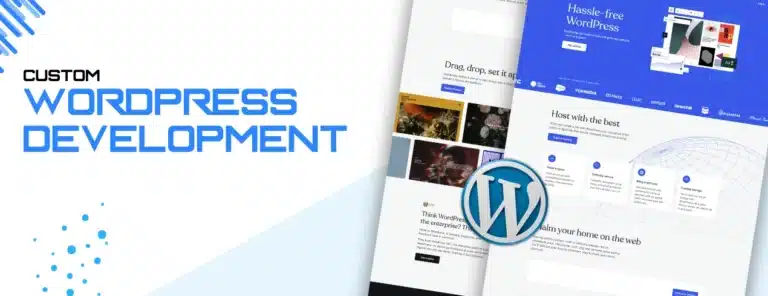Table Of Contents:
- Webflow vs. WordPress: Which Is Better for Your Website? [2025]
- Introduction
- Key Takeaways
- Defining Webflow and WordPress for Modern Websites
- What Sets Webflow Apart in Website Creation
- Understanding WordPress and Its Market Dominance
- Core Philosophies Guiding Each Platform’s Development
- Key Distinctions Impacting Your Platform Choice in 2025
- Comparing Design Flexibility and Visual Customization Potential
- WordPress Theme Customization and Page Builders
- Achieving Unique Brand Identities on Webflow
- Pushing Creative Boundaries With WordPress
- Is Webflow Better Than WordPress for Unfettered Design Freedom?
- Evaluating Ease of Use and the Learning Journey Involved
- Is Webflow More Suitable Than WordPress for Developers and Code Control?
- Examining Content Management System (CMS) Capabilities
- Assessing SEO Features and Website Performance
- Understanding E-Commerce Functionality and Online Store Building
- Analyzing Pricing Models and Overall Cost Implications
- Reviewing Security Measures and Ongoing Maintenance Requirements
- Deciding Which Platform Aligns Best With Your 2025 Website Goals
- Frequently Asked Questions
- Final Thoughts
Webflow vs. WordPress: Which Is Better for Your Website? [2025]
Introduction
In today’s digital landscape, selecting the right platform for website creation is critical for businesses, developers, and content creators alike. The decision between Webflow and WordPress goes far beyond aesthetics; it involves ease of use, design flexibility, SEO performance, development control, and scalability. As companies demand secure and visually appealing websites, understanding the nuances of each platform becomes essential. This article examines the core differences between Webflow and WordPress and explains how each meets content management and design needs in 2025.
Both platforms have reshaped website development—with WordPress dominating as a robust content management system (CMS) and Webflow emerging for its visual-first approach. Business owners, digital marketers, and web developers must balance creative freedom with technical requirements, security, and long-term cost implications. This analysis covers design flexibility, developer control, content management, SEO, e-commerce functionality, pricing, and maintenance to help you decide which platform best aligns with your website goals in 2025.
Key Takeaways
- Webflow offers a visual-first design that speeds up development and enhances creative freedom, while WordPress is renowned for its extensive customization through plugins and themes.
- WordPress is ideal for content management and scalability thanks to its vast ecosystem, whereas Webflow integrates CMS capabilities with simplified hosting and in-built security.
- Both platforms support strong SEO practices, though Webflow has built-in optimization features and WordPress relies on plugins like Yoast SEO.
- For e-commerce, Webflow provides native, easy-to-implement solutions, while WordPress with WooCommerce offers deep customization.
- The optimal choice depends on project needs: creative design and ease of use favor Webflow, while flexibility and extensive custom options favor WordPress.
Defining Webflow and WordPress for Modern Websites
Webflow and WordPress are two major platforms for building websites in 2025. Webflow is a cloud-based builder that merges a visual design editor with code power to create responsive, interactive sites. Its drag-and-drop interface allows designers to develop complex layouts without deep coding knowledge. In contrast, WordPress is a full-fledged CMS powering a majority of websites worldwide. Known for its extensive plugin ecosystem and customizable themes, WordPress provides powerful flexibility for both developers and content creators.
Webflow excels in rapid prototyping, responsive design, and integrated hosting, making it attractive for designers seeking a smooth workflow. WordPress, celebrated for its open-source nature, allows limitless customization with themes, plugins, and custom code. Businesses from large enterprises to niche blogs use each platform based on their scalability, security, and ease of deployment needs.
What Sets Webflow Apart in Website Creation
Webflow distinguishes itself with a design-first approach that unites creative vision and technical execution. Its visual editor provides real-time feedback, enabling designers to implement dynamic animations, interactions, and responsive layouts without manual coding. By integrating hosting and content management, Webflow simplifies development by handling backend tasks and generating clean, semantic code that ensures performance and reliability.
Key features such as reusable symbols, style managers, and version control streamline collaboration among teams. Webflow’s integrated CMS allows non-technical users to update content easily without disrupting design consistency. Its rapid turnaround and modern visual storytelling tools make it ideal for digital projects that demand high creativity and swift deployment.
Understanding WordPress and Its Market Dominance
WordPress is a leading platform due to its flexibility, strong community support, and extensive plugin and theme ecosystem. Evolving from a simple blogging tool, WordPress now powers over 40% of all websites globally. Its open-source framework enables continuous community improvements, vast customizability, and adaptability across countless niches—from e-commerce stores to community forums.
The WordPress dashboard provides content creators with intuitive tools for drafting, publishing, and managing content. Integration with external APIs and services—such as payment gateways via WooCommerce and SEO through Yoast—ensures that WordPress can adapt to evolving market trends. Its global community of developers supports a dynamic ecosystem that maintains WordPress as a robust, scalable solution.
Core Philosophies Guiding Each Platform’s Development
Webflow’s philosophy is built on simplicity, visual empowerment, and integration. It bridges the gap between design and development by mimicking professional design tools while automatically generating exportable code. This reduces the gap between conceptual design and a functioning website.
Conversely, WordPress is founded on openness, flexibility, and community collaboration. Its open-source codebase allows developers worldwide to contribute improvements and customizations. This collective effort produces a highly modular platform that grows with business needs. While Webflow offers a streamlined, all-in-one approach, WordPress emphasizes extensibility and deep customizability, reflecting the contrasting needs of visual designers versus technical developers.
Key Distinctions Impacting Your Platform Choice in 2025
Choosing between Webflow and WordPress depends on several factors:
• Ease of Use: Webflow’s drag-and-drop interface reduces setup complexity and technical overhead. WordPress, however, provides extensive customization but often requires deeper technical knowledge.
• Customization: WordPress offers unparalleled flexibility with thousands of themes and plugins. Webflow delivers integrated solutions that, while highly capable, are less open-ended.
• Third-Party Integrations: Webflow includes native integrations (e.g., Zapier for automation), whereas WordPress relies on additional plugins for similar functionality.
• Security and Maintenance: Webflow’s managed hosting comes with automatic updates and security patches, reducing user responsibilities. WordPress requires regular updates, security monitoring, and potential manual maintenance.
The decision rests on balancing rapid deployment and creative freedom (Webflow) with deep customization and scalability (WordPress).
Comparing Design Flexibility and Visual Customization Potential
Both platforms offer strong design capabilities, though with different approaches:
Webflow’s Visual-First Design Environment
Webflow’s visual editor provides real-time design feedback, allowing pixel-perfect adjustments with drag-and-drop ease. Its automated code generation ensures that the underlying HTML, CSS, and JavaScript remain clean and optimized. This system supports responsive design naturally, offering preview modes for mobile, tablet, and desktop. Advanced animation tools enable designers to create dynamic visual effects and micro-interactions without complex coding.
WordPress Theme Customization and Page Builders
WordPress uses themes and page builders like Elementor, Divi, or Beaver Builder to deliver design flexibility. Although these tools provide many customization options, they generally depend on third-party plugins and custom code. This method allows for virtually unlimited design possibilities but often requires technical expertise to integrate and maintain cohesive performance.
Achieving Unique Brand Identities
Webflow’s in-editor style manager, reusable symbols, and grid system allow brands to establish a consistent look with custom animations and transitions. WordPress can achieve unique identities too, but may involve more manual customization of themes and CSS adjustments by developers.
WordPress Theme Customization and Page Builders
WordPress’s strength lies in its vast library of themes and page builders. Developers can create intricate layouts, customize design with child themes, and extend functionality with custom widgets, CSS, and JavaScript. This modular ecosystem gives users the freedom to tailor every aspect of the website, though it often involves a steeper learning curve and ongoing maintenance challenges.
Achieving Unique Brand Identities on Webflow
Webflow’s intuitive design interface enables brands to craft distinctive identities directly. Custom fonts, color schemes, and layout grids can be set uniformly using its style manager. Reusable symbols and modules ensure that key elements like headers and footers maintain consistency across pages. Native animation tools further enhance branding by adding interactive and visually appealing effects. This integrated approach reduces the need for external tweaks, allowing for a cohesive design without technical overhead.
Pushing Creative Boundaries With WordPress
WordPress thrives on creative control, offering limitless customization options through its extensive ecosystem. Developers can modify themes, write custom plugins, and override defaults to create unique layouts and functionalities. This flexibility makes WordPress ideal for large-scale projects and complex websites that require tailored solutions. However, this comes at the cost of a steeper learning curve and more intensive maintenance. Its open-source nature means that creativity is only limited by technical expertise.
Is Webflow Better Than WordPress for Unfettered Design Freedom?
When it comes to design freedom, Webflow offers an integrated, visual environment that minimizes technical demands while generating clean code. This is advantageous for teams seeking rapid prototyping and visually driven sites. In contrast, WordPress provides infinite custom modifications through plugins and custom code but often requires advanced technical skills. The choice depends on whether immediate, visual design control (Webflow) or deep, flexible customization (WordPress) better meets your project’s needs.
Evaluating Ease of Use and the Learning Journey Involved
Ease of use and the learning curve are critical factors:
Getting Started With Webflow’s Interface
Webflow’s user-friendly dashboard organizes projects, assets, and templates clearly. Its drag-and-drop editor and live preview simplify the process, making it accessible for beginners and non-technical users. Built-in tutorials and documentation further ease onboarding, reducing the overall learning curve.
The WordPress Dashboard and Initial Setup
WordPress’s dashboard offers extensive configuration options, which can seem overwhelming at first. With many menus for posts, pages, plugins, and themes, beginners may require more time to learn. However, once mastered, WordPress provides tremendous flexibility and power through its customizable interface and vast community support.
Overall Learning Investment
Webflow typically requires less time to achieve basic proficiency due to its integrated environment. WordPress, while offering greater long-term customization, demands a more significant initial time investment to fully leverage its capabilities. The decision should consider your team’s technical comfort and available time for learning new systems.
Is Webflow More Suitable Than WordPress for Developers and Code Control?
For developers, control over code and advanced functionality is essential:
Developer Tools and Code Quality in Webflow
Webflow strikes a balance by enabling designers to build visually while still offering clean, exportable code. Developers can inspect generated HTML, CSS, and JavaScript to ensure quality, and integrate custom code when needed. This reduces manual coding and speeds up project completion.
Advanced Developer Control in WordPress
WordPress is built for developers; its extensive hooks, filters, and theme frameworks allow for complete customization. Developers can write custom plugins and modify core files as necessary, though this often requires deeper technical expertise and ongoing maintenance.
Choosing Based on Project Needs
If speed-to-market and minimized coding are priorities, Webflow is attractive. For projects requiring detailed backend control and extensive custom features, WordPress’s flexibility makes it the preferred option. The decision depends on your project’s technical requirements and the available development skills.
Examining Content Management System (CMS) Capabilities
Both platforms support robust CMS functionality, yet they differ in approach:
Webflow’s Integrated CMS
Webflow’s built-in CMS lets designers update content in real time within the same interface used for design. This reduces context switching and is ideal for simpler or visually focused sites like portfolios and landing pages.
WordPress’s Mature CMS
WordPress’s CMS, powered by Gutenberg and supplemented by thousands of plugins, offers advanced content management features. It supports custom post types, detailed categorization, and complex editorial workflows, making it well-suited for content-intensive sites.
Choosing Based on Content Needs
For streamlined, visually driven content updates, Webflow is efficient. For large-scale publications and highly detailed content organization, WordPress provides unbeatable flexibility.
Assessing SEO Features and Website Performance
SEO and performance are critical for website success:
SEO Tools in Webflow
Webflow offers built-in SEO settings like editable meta tags, canonical links, and clean code generation. These features, combined with automatic performance optimization (integrated CDN and fast hosting), yield consistently high load speeds and solid search rankings without extra plugins.
SEO Enhancements in WordPress
WordPress relies on popular plugins such as Yoast SEO to guide detailed on-page optimization, from keyword analysis to sitemap creation. While these plugins offer deep customization, they require regular updates and careful configuration to maintain peak performance.
Comparative SEO Overview
Both platforms deliver strong SEO capabilities. Webflow provides simplicity and automated performance, while WordPress offers granular control at the expense of added complexity. Choose based on your comfort with plugin configuration and desired management overhead.
SEO Comparison Table
| Feature | Webflow | WordPress | Benefit | Example/Comparison Value |
|---|---|---|---|---|
| Built-in SEO Controls | Direct editing for meta tags and redirects | Plugins like Yoast | Simplifies on-page optimization | Webflow: Out-of-box SEO features |
| Code Quality | Clean, semantic code | Varies by theme and plugin | Enhances indexing | Webflow minimizes code bloat |
| Speed Optimization | Integrated CDN and fast hosting | Caching plugins and manual setup | Fast load times | Webflow offers consistent speed |
| Plugin Ecosystem | Limited need for extra plugins | Extensive plugins for SEO tweaks | Deeper customization | WordPress supports wide range plugins |
| Maintenance | Automatic updates | Requires regular manual updates | Lower maintenance overhead | Webflow reduces management effort |
Understanding E-Commerce Functionality and Online Store Building
E-commerce capabilities are evolving rapidly:
Webflow’s Native E-Commerce Solutions
Webflow provides built-in tools for managing online stores. It allows designers to create product pages, customizable shopping carts, and secure checkout systems within the same interface. This integration simplifies store management and ensures consistent design without relying on multiple vendors.
WordPress with WooCommerce
WordPress, paired with WooCommerce, offers extensive customization for online stores. It supports complex product categorization, varied payment integrations, and international shipping configurations. However, this flexibility requires more technical setup and regular maintenance.
Choosing Based on E-Commerce Needs
For small to medium-sized stores that prioritize design consistency and ease of use, Webflow is an excellent choice. For large-scale or complex e-commerce operations needing advanced customization, WordPress with WooCommerce is preferable.
Analyzing Pricing Models and Overall Cost Implications
Cost considerations vary significantly:
Webflow’s Subscription and Hosting Model
Webflow uses a subscription model that covers hosting, SSL certificates, and automatic updates. This all-in-one pricing makes costs predictable and simplifies budgeting for small businesses and freelancers.
WordPress’s Variable Costs
WordPress itself is free, but total ownership costs include domain registration, hosting, premium themes, plugins, and potential custom development. While initial costs may be lower, ongoing maintenance and customization expenses can add up over time.
Cost Comparison Overview
If predictable pricing and lower maintenance are priorities, Webflow may be more cost-effective over the long term. For projects requiring deep customization and scalability, WordPress can offer lower initial costs but may incur variable long-term expenses.
Pricing Comparison Table
| Category | Webflow | WordPress | Advantage | Example/Cost Range |
|---|---|---|---|---|
| Initial Setup Cost | Transparent subscription fees | Free core; additional hosting costs | Predictable pricing | Webflow: $12-$36/month; WordPress: $5-$50/month hosting |
| Hosting | Included in subscription | Requires separate hosting | Simplified cost structure | Webflow: Managed hosting |
| Themes and Plugins | Limited reliance on extras | Wide range; many free plus premium | Extensive customization | WordPress premiums: $30–$100 each |
| Maintenance | Automated updates and security | Manual updates needed | Lower overhead | Webflow reduces ongoing effort |
| Scalability | Predictable upgrade paths | Flexible via custom hosting | Adaptability for high traffic | WordPress scalable with VPS/dedicated |
Reviewing Security Measures and Ongoing Maintenance Requirements
Security and maintenance are critical:
Webflow’s Managed Security
Webflow’s all-in-one solution includes automatic updates, backups, and security patches. Its managed hosting ensures that SSL certificates and data protection are handled seamlessly, reducing user responsibility and risk.
WordPress Security Responsibilities
WordPress requires active management. Users must update plugins, themes, and core files frequently, often using additional security plugins like Wordfence or Sucuri to guard against vulnerabilities. This proactive approach demands technical expertise and time.
Security Comparison Table
| Feature | Webflow | WordPress | Benefit | Example/Comparison Value |
|---|---|---|---|---|
| Automatic Updates | Fully automatic | Manual or plugin-driven updates | Lower maintenance | Webflow handles all updates automatically |
| Hosting Security | Enterprise-level, managed | Depends on host; requires extra setup | Robust built-in security | Webflow provides SSL and backups |
| Backup and Recovery | Automated backups included | Requires manual setup | Simplified recovery process | Webflow offers integrated solutions |
| User Responsibility | Minimal ongoing management | Higher technical involvement | Ease for non-technical users | Webflow reduces user burden |
Deciding Which Platform Aligns Best With Your 2025 Website Goals
When planning your 2025 website, consider these factors:
When to Choose Webflow
Choose Webflow if you need rapid prototyping, visually engaging design, and minimal technical overhead. Its integrated environment covers hosting, security, and CMS—all of which are ideal for creative agencies and small businesses seeking a quick, stylish launch.
When to Choose WordPress
Opt for WordPress if your project demands advanced customization, extensive content management, and complex e-commerce functionality. It is well-suited for large-scale projects, enterprises, or organizations with in-house development teams that can manage the technical complexity.
Evaluating Future Scalability
WordPress offers scalability through various hosting options and extensive plugins, making it ideal for growing, content-heavy sites. Webflow is efficient for small to medium enterprises but may face limits with extremely large-scale or highly complex sites.
Making Your Decision
Assess your technical resources, budget, and long-term goals. Webflow provides predictability and ease of use, while WordPress offers unparalleled customization potential. Your choice should align with your specific needs for performance, scalability, and design.
Is Webflow Better Than WordPress for Your Unique Website Vision?
Ultimately, whether Webflow is better than WordPress depends on your priorities. If you value an integrated, low-maintenance system with strong design tools, Webflow is ideal. If deep customization and flexible control are paramount, WordPress is likely the better fit.
Frequently Asked Questions
Q: What is the main difference between Webflow and WordPress?
A: Webflow offers a visual-first design environment with integrated hosting and CMS, ideal for rapid prototyping. WordPress is an open-source CMS renowned for its extensive customization options and scalability through plugins and themes.
Q: How do the SEO features compare between Webflow and WordPress?
A: Webflow provides built-in SEO tools with clean, semantic code and fast hosting, making on-page optimization straightforward. WordPress relies on SEO plugins like Yoast SEO for deeper customization, which require more technical management.
Q: Which platform is easier for beginners to learn?
A: Webflow is easier for beginners due to its intuitive drag-and-drop interface and integrated environment. WordPress offers more power but comes with a steeper learning curve because of its extensive dashboard and numerous configuration options.
Q: Can WordPress be scaled for large e-commerce websites?
A: Yes, especially with WooCommerce, WordPress can be scaled to handle large e-commerce operations. However, successful scaling requires careful management of hosting, security, and performance.
Q: How does pricing impact the decision between Webflow and WordPress?
A: Webflow’s subscription model offers predictable costs with integrated hosting and security. WordPress itself is free, but total ownership costs can rise with separate hosting, premium themes, and plugins. The choice depends on budget priorities and desired maintenance overhead.
Q: Is it possible to integrate custom code in Webflow and WordPress?
A: Yes, both platforms support custom code. Webflow allows custom HTML, CSS, and JavaScript within its editor, while WordPress provides extensive customization possibilities via theme modifications and custom plugins.
Q: Which platform is more secure and easier to maintain?
A: Webflow is generally more secure and easier to maintain because it handles hosting, updates, and security automatically. WordPress offers robust security but requires regular manual updates and active management.
Final Thoughts
Both Webflow and WordPress offer compelling advantages for website creation in 2025. Webflow provides an accessible, visually oriented design experience with integrated hosting and low maintenance—ideal for quick deployment and creative projects. WordPress delivers deep customization and scalability through its powerful CMS and plugin ecosystem, making it a strong choice for complex, content-rich sites. Ultimately, your decision should reflect your project’s technical requirements, creative goals, and long-term growth strategy.
Read More : Is Webflow Good for Big Websites?

![Webflow vs. WordPress: Which Is Better for Your Website? [2025]](https://thebytecraft.net/wp-content/uploads/2025/05/textbuilder_fluxzew-tty.jpg)





